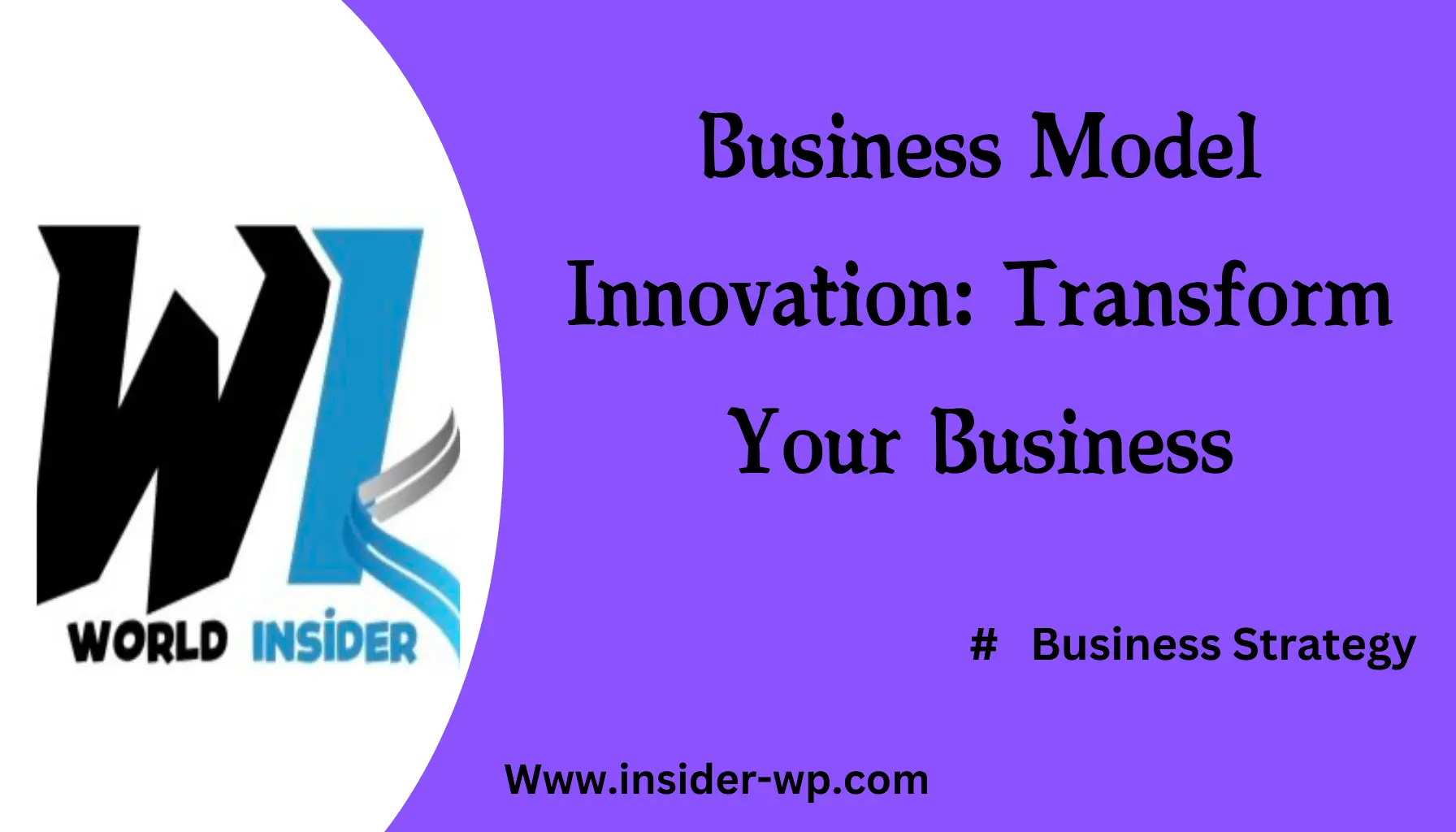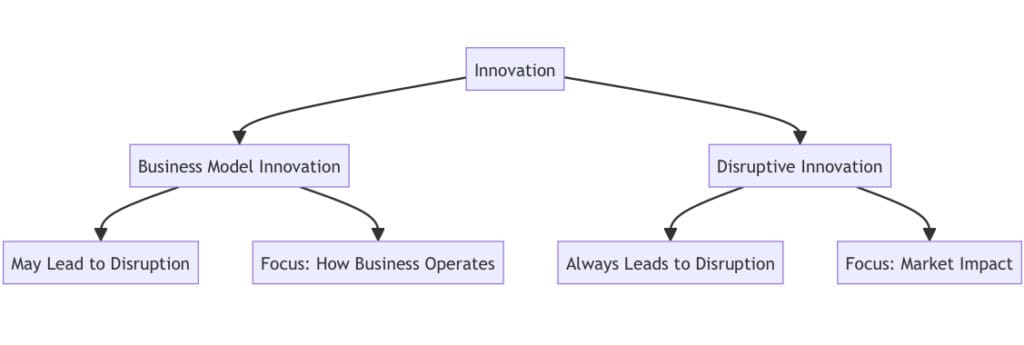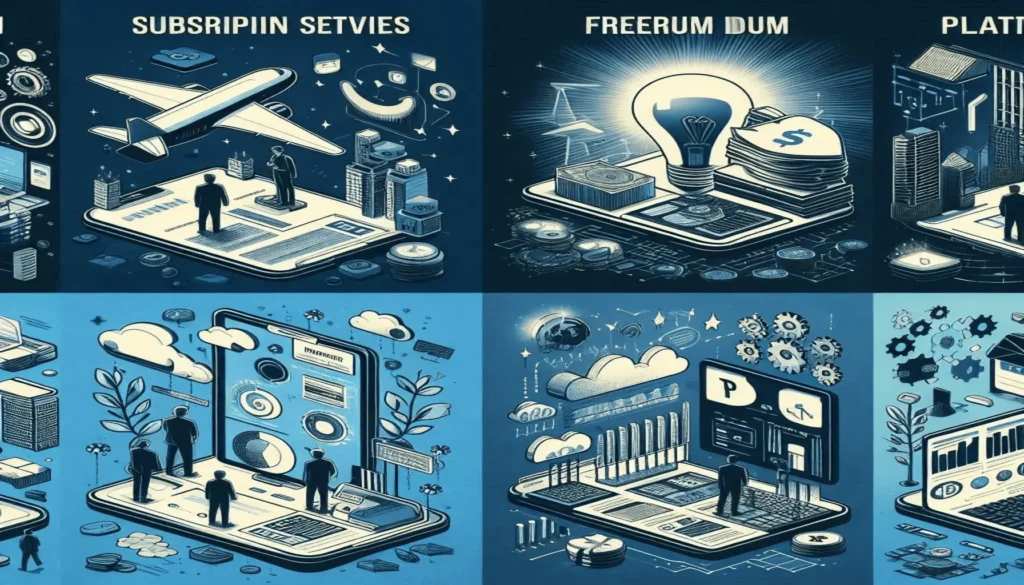Business Model Innovation: Transform Your Business

In today’s rapidly evolving business landscape, the question “What is business model innovation?” has become increasingly crucial for companies seeking to maintain their competitive edge. Business model innovation is the process of fundamentally rethinking and redesigning how a company creates, delivers, and captures value. It goes beyond mere product or process improvements, encompassing a holistic transformation of the entire business structure.
The importance of innovation in business models cannot be overstated. As markets become more dynamic and unpredictable, traditional business approaches are often insufficient to keep pace with changing customer demands and technological advancements. Business model innovation drives growth by enabling companies to adapt to new market realities, exploit emerging opportunities, and stay ahead of competitors.
In this comprehensive guide, we’ll explore the intricate relationship between business model innovation and digital transformation, delving into how companies create value through innovation and the steps required to implement successful business model changes. We’ll examine various types of business models, innovation strategies, and real-world examples of business model innovation in startups and established companies alike.
By the end of this article, you’ll have a thorough understanding of:
- The key components of an innovative business model
- How business model innovation differs from other forms of innovation
- The importance of innovation in business models
- Steps to implement business model innovation
- Benefits of business model innovation for companies
Let’s embark on this journey to uncover the transformative power of business model innovation and how it can propel your company towards sustainable success in an ever-changing business environment.
This diagram illustrates the key components and outcomes of business model innovation, showcasing how it integrates various elements like value creation, digital transformation, revenue streams, market disruption, and competitive advantage.
As we delve deeper into the concept of business model innovation, it’s important to understand that this process is not just about making incremental changes. It’s about fundamentally rethinking how a business operates and creates value. According to a study by BCG, business model innovators earn 4% higher operating margins on average over a five-year period compared to traditional innovators.
In the following sections, we’ll explore the various aspects of business model innovation, providing you with the knowledge and tools to transform your business for the digital age. Whether you’re a startup founder or a leader in an established company, understanding and implementing business model innovation is crucial for long-term success in today’s dynamic business environment.
Understanding Business Models and Innovation

What is a business model?
A business model is the backbone of any company, defining how it creates, delivers, and captures value. It’s not just about making money; it’s about the entire system of how a business operates and competes in the market.
Think of a business model as a blueprint that answers these key questions:
- Who are your customers?
- What value do you offer them?
- How do you deliver that value?
- How do you make money from it?
For example, Netflix’s business model evolved from DVD rentals by mail to a subscription-based streaming service, fundamentally changing how they deliver value to customers.
Key components of an innovative business model
An innovative business model often reimagines one or more of these core components:
- Value Proposition: What unique benefit do you offer customers?
- Customer Segments: Who are your target customers?
- Channels: How do you reach and interact with customers?
- Customer Relationships: How do you build and maintain customer relationships?
- Revenue Streams: How does the business make money?
- Key Resources: What assets are crucial to your business?
- Key Activities: What core activities drive your business?
- Key Partnerships: Who are your strategic partners or suppliers?
- Cost Structure: What are the main costs in your business model?
Innovative business models often disrupt traditional approaches by reimagining one or more of these components. For instance, Airbnb innovated by turning homeowners into hoteliers, disrupting the traditional hospitality industry.
Types of business models
There’s no one-size-fits-all approach to business models. Here are some common types:
- Subscription Model: Customers pay a recurring fee for access to a product or service (e.g., Netflix, Spotify)
- Freemium Model: Basic services are free, while premium features are paid (e.g., Dropbox, LinkedIn)
- Marketplace Model: Platform connecting buyers and sellers (e.g., Amazon, Uber)
- Razor and Blade Model: Core product sold cheap, with expensive proprietary consumables (e.g., Gillette razors and blades)
- Crowdsourcing Model: Leveraging a large group of people for ideas or funding (e.g., Wikipedia, Kickstarter)
- One-for-One Model: For each product sold, one is donated (e.g., TOMS Shoes)
- Franchise Model: Selling the right to use your business model (e.g., McDonald’s)
Each of these models has its unique way of creating and capturing value. The key is choosing the right model for your business and market.
The concept of business innovation
Business innovation goes beyond just creating new products or services. It’s about finding new ways to create value for customers and the company. This can involve:
- Developing new products or services
- Improving existing processes
- Finding new markets or customer segments
- Changing how products are marketed or delivered
- Reimagining the entire business model
Innovation doesn’t always mean inventing something entirely new. Often, it’s about applying existing ideas in new ways or to new markets.
How business model innovation differs from other innovation strategies
Business model innovation is distinct from other types of innovation. Here’s a comparison:
| Type of Innovation | Focus | Example |
| Product Innovation | Creating new products or improving existing ones | Apple introducing the iPhone |
| Process Innovation | Improving internal processes for efficiency or quality | Toyota’s lean manufacturing system |
| Marketing Innovation | New ways to promote and sell products or services | Dollar Shave Club’s viral marketing videos |
| Business Model Innovation | Fundamentally changing how the business creates and captures value | Amazon expanding from online bookstore to cloud computing provider (AWS) |
Business model innovation is often more impactful and harder for competitors to copy than other forms of innovation. While a new product can be reverse-engineered or a new process can be imitated, a successful new business model often requires significant organizational changes that are difficult to replicate.
For instance, when Apple introduced the iPod, it wasn’t just about the product (product innovation). The game-changer was the iTunes store (business model innovation), which revolutionised how people buy and consume music.
In conclusion, understanding business models and innovation is crucial for any company looking to stay competitive in today’s fast-paced business environment. By grasping these concepts, businesses can better position themselves to create unique value propositions and capture market opportunities that others might miss.
Defining Business Model Innovation

What is business model innovation?
Business model innovation is the process of fundamentally rethinking and redesigning how a company creates, delivers, and captures value. It’s not just about tweaking existing processes or products; it’s about reimagining the entire business framework.
Let’s break it down:
- Creation of value: This involves developing new products, services, or experiences that customers find valuable.
- Delivery of value: This refers to how the company gets its offerings to customers, including distribution channels and customer relationships.
- Capture of value: This is about how the company makes money from its value creation and delivery.
Business model innovation can involve changes in one, two, or all three of these areas. The key is that these changes are significant and transformative, not just incremental improvements.
The role of business model innovation in creating competitive advantage
Business model innovation plays a crucial role in creating and maintaining competitive advantage. Here’s how:
- Differentiation: A unique business model can set a company apart from competitors, making it harder for others to replicate their success.
- Efficiency: Innovative business models often find ways to deliver value more efficiently, reducing costs and increasing profitability.
- Customer lock-in: Some business model innovations create ecosystems or platforms that make it difficult for customers to switch to competitors.
- Scalability: Innovative business models can often scale more easily, allowing companies to grow rapidly and dominate markets.
- Adaptability: Companies that excel at business model innovation are better equipped to adapt to changing market conditions and customer needs.
How companies create value through innovation
Companies create value through business model innovation in several ways:
- Solving unmet needs: By identifying and addressing customer pain points that competitors have overlooked.
- Improving accessibility: Making products or services available to previously underserved markets or customer segments.
- Enhancing convenience: Simplifying processes or removing friction points in the customer journey.
- Customisation: Offering personalised solutions that better meet individual customer needs.
- Cost reduction: Finding ways to deliver value at a lower cost, either passing savings to customers or increasing profitability.
- Creating new revenue streams: Identifying novel ways to monetise existing assets or capabilities.
Let’s look at a table comparing traditional value creation versus innovative value creation:
| Aspect | Traditional Value Creation | Innovative Value Creation |
| Focus | Product features | Customer experience |
| Pricing | Cost-plus or competitive | Value-based |
| Distribution | Standard channels | Multi-channel or direct-to-consumer |
| Customer Engagement | Transactional | Relationship-based |
| Revenue Model | One-time sales | Recurring revenue (e.g., subscriptions) |
Business model innovation vs. disruptive innovation
While often used interchangeably, business model innovation and disruptive innovation are distinct concepts:
Business Model Innovation:
- Can occur within established companies or startups
- Focuses on changing how a business operates and creates value
- May or may not lead to market disruption
- Can be incremental or radical
Disruptive Innovation:
- Typically starts in low-end or new market footholds
- Initially deemed inferior by most of an incumbent’s customers
- Steadily moves upmarket, eventually displacing established competitors
- Always leads to market disruption
Here’s a diagram to illustrate the relationship between these concepts:

It’s worth noting that some of the most successful companies have combined both business model innovation and disruptive innovation. For example, Amazon’s e-commerce model was both a business model innovation (in how they sold books) and a disruptive innovation (in how it eventually transformed retail).
In conclusion, business model innovation is a powerful tool for companies to create value, gain competitive advantage, and potentially disrupt markets. By rethinking the fundamental aspects of how a business operates, companies can unlock new opportunities for growth and success in an ever-changing business landscape.
The Need for Business Model Innovation

In today’s fast-paced business world, standing still is essentially moving backwards. Companies that fail to innovate their business models risk becoming obsolete, outcompeted, or simply irrelevant. But what’s driving this urgent need for business model innovation? Let’s dive in.
Driving Forces Behind Business Model Innovation
Technological Advancements and Digital Transformation
The rapid pace of technological change is perhaps the most significant driver of business model innovation. From artificial intelligence to blockchain, new technologies are constantly emerging and reshaping industries.
- AI and Machine Learning: These technologies are enabling personalized customer experiences, predictive maintenance, and data-driven decision making.
- Internet of Things (IoT): Connected devices are creating new service-based business models in industries from manufacturing to healthcare.
- Cloud Computing: This has lowered barriers to entry for startups and enabled new ‘as-a-service’ business models.
For instance, Netflix’s shift from DVD rentals to streaming wasn’t just a change in delivery method – it was a complete business model overhaul driven by advancements in internet technology and cloud computing.
Changing Customer Expectations
Today’s customers expect more than ever before: personalization, instant gratification, and seamless experiences across all touchpoints.
- On-demand economy: Companies like Uber and Airbnb have set new standards for convenience and accessibility.
- Personalization: Customers now expect products and services tailored to their individual preferences.
- Sustainability: There’s a growing demand for environmentally friendly and socially responsible products and services.
Consider how Spotify revolutionized the music industry by offering personalized playlists and discovering new music tailored to individual tastes – a far cry from the one-size-fits-all approach of traditional radio or CD sales.
Market Disruption
Disruptive innovations are constantly reshaping industries, often led by startups unencumbered by legacy systems or traditional thinking.
- New entrants: Startups with innovative business models can quickly gain market share (e.g., Robinhood in finance).
- Cross-industry competition: Companies are increasingly competing across traditional industry boundaries (e.g., Apple entering finance with Apple Pay).
- Shifting regulations: Changes in laws and regulations can open up new opportunities or threaten existing models.
The rise of fintech companies like TransferWise (now Wise) disrupted the traditional banking model for international money transfers by offering a peer-to-peer model with significantly lower fees.
Sustainability Concerns
Environmental and social sustainability is no longer just a nice-to-have – it’s becoming a core business imperative.
- Circular economy: There’s growing interest in business models that minimize waste and maximize resource efficiency.
- Social impact: Consumers and investors are increasingly favoring companies that demonstrate positive social impact.
- Regulatory pressure: Governments are implementing stricter environmental regulations, forcing companies to adapt.
Patagonia’s Worn Wear program, which repairs and resells used clothing, is a great example of a business model innovation driven by sustainability concerns.
Signs That Your Business Model Needs Innovation
How do you know if your business model is due for an overhaul? Here are some telltale signs:
- Declining profitability: If your margins are shrinking despite your best efforts, it might be time to rethink your business model.
- Loss of market share: Are new competitors eating into your customer base?
- Customer churn: If you’re losing customers faster than you’re acquiring them, something’s wrong.
- Industry shifts: Has your industry changed dramatically while your business has remained the same?
- Difficulty scaling: If growth seems to require proportional increases in costs, your model might not be scalable.
- Overreliance on a single product or customer: This makes your business vulnerable to market changes.
Adapting Business Models to Changing Environments
Adapting your business model isn’t a one-time event – it’s an ongoing process. Here’s a simple framework for staying agile:
- Monitor: Keep a close eye on industry trends, customer behavior, and emerging technologies.
- Analyze: Regularly assess your business model’s strengths and weaknesses in light of these changes.
- Ideate: Brainstorm potential adaptations or completely new business models.
- Test: Run small-scale experiments to test new ideas before full implementation.
- Implement: Roll out successful innovations across your organization.
- Iterate: Continuously refine and improve your model based on results and feedback.
Remember, the goal isn’t to chase every trend, but to stay relevant and competitive in a changing landscape. As Amazon’s Jeff Bezos famously said, “We can’t be in survival mode. We have to be in growth mode.”
In conclusion, business model innovation isn’t just about staying competitive – it’s about staying relevant. By keeping a finger on the pulse of technological advancements, customer expectations, market disruptions, and sustainability concerns, you can ensure your business model evolves with the times, creating new value for customers and stakeholders alike.
Types of Business Model Innovation

When we talk about business model innovation, it’s not a one-size-fits-all approach. Companies can innovate in various ways, each focusing on different aspects of their business model. Let’s dive into the main types of business model innovation and see how they can transform a company’s operations and market position.
Value Proposition Innovation and Value Proposition Design
Value proposition innovation is all about rethinking what you offer to customers and why they should choose you over competitors. It’s about creating new value or delivering existing value in novel ways.
Key aspects of value proposition innovation:
- Identifying unmet customer needs
- Solving customer problems in unique ways
- Enhancing product or service features
- Improving the overall customer experience
Value proposition design, a concept popularized by Alexander Osterwalder, provides a structured approach to innovating your value proposition. It involves:
- Creating a customer profile:
- Customer jobs (tasks customers are trying to perform)
- Customer pains (frustrations and challenges)
- Customer gains (benefits they’re seeking)
- Designing a value map:
- Products and services
- Pain relievers
- Gain creators
By aligning your value map with the customer profile, you can create a compelling value proposition that resonates with your target audience.
Example: When Apple introduced the iPod, they innovated their value proposition from “We sell computers” to “1000 songs in your pocket”. This shift in value proposition opened up a whole new market for Apple.
Revenue Model Innovation and New Revenue Streams
Revenue model innovation involves changing how a company makes money. It can include finding new revenue streams or fundamentally altering existing ones.
Common types of revenue models:
- Transaction-based (one-time sales)
- Subscription-based (recurring revenue)
- Freemium (basic services for free, premium features for a fee)
- Advertising-based
- Licensing or franchising
- Pay-per-use or metered services
Revenue model innovation often involves combining multiple revenue streams or shifting from one model to another.
Example: Netflix’s transition from a DVD rental service (transaction-based) to a streaming platform (subscription-based) is a prime example of revenue model innovation.
Cost Structure Innovation
Cost structure innovation focuses on finding new ways to reduce costs or allocate resources more efficiently. This can lead to higher profit margins or allow companies to offer more competitive pricing.
Strategies for cost structure innovation:
- Leveraging technology for automation
- Optimising supply chain and logistics
- Implementing lean manufacturing principles
- Outsourcing non-core activities
- Adopting shared economy models
Example: Airbnb innovated the cost structure of the hospitality industry by leveraging existing assets (people’s homes) instead of building and maintaining hotels.
Customer Segment Innovation and Customer-Centric Approaches
Customer segment innovation involves identifying new customer groups or redefining existing segments. It’s about finding untapped markets or serving existing markets in new ways.
Customer-centric approaches to innovation:
- Conducting in-depth customer research
- Creating detailed customer personas
- Implementing customer feedback loops
- Personalising products or services
- Developing niche market strategies
Example: When Uber introduced Uber Eats, they innovated their customer segment by targeting not just people who need rides, but also those who want food delivered.
Channel Innovation
Channel innovation focuses on finding new ways to reach and interact with customers. This can involve creating new distribution channels or reimagining existing ones.
Types of channel innovation:
- Direct-to-consumer models
- Omnichannel strategies
- Digital marketplaces
- Pop-up stores or experiences
- Partnerships and collaborations
Example: Dollar Shave Club disrupted the razor industry by selling directly to consumers through an online subscription model, bypassing traditional retail channels.
Resource and Process Innovation
Resource and process innovation involves rethinking how a company uses its assets and organizes its activities to create value.
Areas for resource and process innovation:
- Talent acquisition and management
- Knowledge management systems
- Agile methodologies
- Open innovation and crowdsourcing
- Circular economy principles
Example: Toyota’s lean manufacturing system, which focuses on minimizing waste and maximizing efficiency, is a classic example of process innovation.
Bringing It All Together: The Business Model Innovation Matrix
To visualize how these types of innovation interact, let’s consider the Business Model Innovation Matrix:
| Type of Innovation | Internal Focus | External Focus |
| Value-Based | Resource and Process Innovation | Value Proposition Innovation |
| Customer-Based | Cost Structure Innovation | Customer Segment Innovation |
| Financial-Based | Revenue Model Innovation | Channel Innovation |
This matrix helps companies identify which areas of their business model they’re innovating and ensures a balanced approach to innovation.
Remember, successful business model innovation often involves combining multiple types of innovation. By understanding these different types, companies can strategically reinvent themselves to stay competitive in an ever-changing business landscape.
Read also : Business Model Innovation Examples: Revolutionizing Industries and Driving Success
The Process of Business Model Innovation

Ever wondered how companies like Amazon or Uber completely revolutionized their industries? It all comes down to mastering the art of business model innovation. But don’t worry, you don’t need to be a tech giant to shake things up. Let’s dive into the nitty-gritty of how you can innovate your business model, step by step.
Steps to Implement Business Model Innovation
Innovating your business model isn’t about throwing darts in the dark. It’s a methodical process that requires careful planning and execution. Here’s how you can go about it:
- Analysing the current business model
- Take a good, hard look at how your business currently operates
- Identify your value proposition, customer segments, revenue streams, and cost structure
- Use tools like the Business Model Canvas (more on this later) to visualise your current model
- Identifying opportunities for innovation
- Spot gaps in the market that your competitors have overlooked
- Listen to your customers – what pain points are they experiencing?
- Keep an eye on emerging technologies that could disrupt your industry
- Designing new business model options
- Brainstorm creative solutions to address the opportunities you’ve identified
- Don’t be afraid to think outside the box – remember, Airbnb didn’t invent accommodation, they just reimagined it
- Consider multiple options – you’re not committing to anything just yet
- Prototyping and testing
- Create a minimum viable product (MVP) for your new business model
- Test it with a small group of customers or in a limited market
- Gather feedback and be prepared to iterate based on what you learn
- Implementation and scaling
- Once you’ve validated your new model, it’s time to roll it out
- Develop a clear implementation plan, including timelines and resource allocation
- Monitor key performance indicators (KPIs) closely as you scale
Remember, this isn’t a one-time process. The most successful companies are those that continuously innovate their business models to stay ahead of the curve.
Tools and Frameworks for Business Model Innovation
Now, let’s talk about some handy tools that can help you navigate the tricky waters of business model innovation:
Business Model Canvas
The Business Model Canvas, developed by Alexander Osterwalder, is like a blueprint for your business. It’s a visual chart with elements describing your value proposition, infrastructure, customers, and finances. Here’s why it’s brilliant:
- It gives you a bird’s-eye view of your entire business model on one page
- It helps you spot connections between different parts of your business
- It’s a great tool for brainstorming new business model ideas
Blue Ocean Strategy
Imagine sailing into uncharted waters, free from cutthroat competition. That’s the essence of the Blue Ocean Strategy. Developed by W. Chan Kim and Renée Mauborgne, this framework encourages you to:
- Create uncontested market space (your ‘blue ocean’)
- Make the competition irrelevant
- Create and capture new demand
- Break the value-cost trade-off
A classic example? Cirque du Soleil. They didn’t just compete with traditional circuses; they reinvented the circus experience, appealing to a whole new audience.
Jobs-to-be-Done Framework
This framework, popularized by Clayton Christensen, focuses on understanding the ‘job’ that customers are trying to get done. The key idea? People don’t buy products; they hire them to do a job. For instance:
- People don’t buy a quarter-inch drill bit; they hire it to make a quarter-inch hole
- Understanding these ‘jobs’ can lead to innovative business models that better serve customer needs
Business Strategy Frameworks for Innovation
While the tools above are specific to business model innovation, there are broader strategy frameworks that can complement your innovation efforts:
- Porter’s Five Forces: Analyze the competitive forces in your industry to identify areas ripe for innovation.
- PEST Analysis: Examine Political, Economic, Social, and Technological factors that might influence your business model.
- Design Thinking: Use this human-centered approach to generate innovative solutions to complex problems.
- Lean Startup Methodology: Apply the build-measure-learn cycle to rapidly test and iterate your business model ideas.
Remember, these frameworks are tools, not rules. Use them to guide your thinking, but don’t be afraid to colour outside the lines. After all, true innovation often comes from challenging conventional wisdom.
So, ready to shake things up? With these steps, tools, and frameworks in your arsenal, you’re well-equipped to embark on your business model innovation journey. Who knows? Your company could be the next case study in business innovation that we’ll all be talking about!
Challenges in Business Model Innovation

Let’s face it: transforming your business model isn’t a walk in the park. It’s more like trying to change the wheels on a moving car. Tricky, right? But don’t worry, we’ve got your back. Let’s dive into the major hurdles you might face when innovating your business model and how to leap over them like a pro.
Overcoming Organizational Inertia
Ever tried to push a boulder uphill? That’s what organizational inertia feels like. It’s that stubborn resistance to change that can make your innovation efforts feel like you’re wading through treacle.
Here’s why it happens:
- Comfort with the status quo (Hey, if it ain’t broke, why fix it?)
- Fear of the unknown (Change is scary, mate!)
- Established processes and systems (We’ve always done it this way!)
- Lack of skills or knowledge for new approaches (What the heck is a ‘platform business model’ anyway?)
To overcome this inertia:
- Communicate the need for change clearly and often
- Involve employees in the innovation process
- Provide training and support for new skills
- Celebrate small wins to build momentum
Remember, as the saying goes, “The only constant in life is change.” Embrace it!
Managing the Risks of Business Model Innovation
Innovation and risk go together like Vegemite and toast. You can’t have one without the other. But don’t let that scare you off. The key is to manage these risks smartly.
Common risks include:
- Financial risks (What if we invest a ton and it doesn’t pay off?)
- Reputational risks (What if our customers hate the new model?)
- Operational risks (Can we actually pull this off?)
- Competitive risks (What if our competitors beat us to it?)
To manage these risks effectively:
- Start small with pilot projects
- Use data-driven decision making
- Have a contingency plan (Always have a Plan B, folks!)
- Monitor key performance indicators closely
As Richard Branson once said, “You don’t learn to walk by following rules. You learn by doing, and by falling over.” So, don’t be afraid to take calculated risks!
Balancing Innovation with Existing Operations
Here’s a real head-scratcher: how do you keep the lights on while you’re busy reimagining your entire business? It’s like trying to renovate your house while you’re still living in it. Tricky, but not impossible.
The challenge lies in:
- Allocating resources (time, money, people) between old and new
- Maintaining current revenue streams while investing in future ones
- Keeping existing customers happy while attracting new ones
- Managing potentially conflicting cultures and processes
To strike the right balance:
- Create a separate innovation unit or team
- Use the “ambidextrous organisation” model
- Set clear goals and metrics for both existing and new operations
- Foster a culture that values both stability and innovation
Remember, it’s not about choosing between the old and the new. It’s about finding the sweet spot where both can thrive.
Dealing with Uncertainty and Failure
Let’s be real: when you’re innovating, you’re venturing into uncharted territory. It’s like being an explorer in the digital age. You might strike gold, or you might fall flat on your face. The key is learning to dance with uncertainty and bounce back from failure.
Challenges in this area include:
- Making decisions with incomplete information
- Coping with the emotional toll of setbacks
- Knowing when to persist and when to pivot
- Learning from failures without being discouraged
Strategies for dealing with uncertainty and failure:
- Adopt a lean startup approach (Build, measure, learn, repeat!)
- Cultivate a growth mindset in your team
- Create a “safe to fail” environment
- Use scenario planning to prepare for different outcomes
As Thomas Edison said, “I have not failed. I’ve just found 10,000 ways that won’t work.” Each failure is a stepping stone to success!
To sum it up, here’s a handy table of the challenges and their solutions:
| Challenge | Key Solutions |
| Organizational Inertia | Clear communication, employee involvement, training, celebrate wins |
| Risk Management | Pilot projects, data-driven decisions, contingency planning, close monitoring |
| Balancing Old and New | Separate innovation units, ambidextrous model, clear goals, balanced culture |
| Uncertainty and Failure | Lean startup approach, growth mindset, safe-to-fail environment, scenario planning |
Remember, mates, these challenges aren’t roadblocks; they’re opportunities to learn, grow, and ultimately create a more resilient and innovative business. So, roll up your sleeves and get ready to tackle them head-on!
Success Stories of Business Model Innovation

Let’s dive into some cracking examples of business model innovation that have turned industries on their heads. These stories aren’t just about companies hitting the jackpot – they’re about outfits that dared to rethink how business is done.
Examples of Business Model Innovation in Startups
Startups are often the poster children for business model innovation. Why? Because they’re nimble, hungry, and not weighed down by “that’s how we’ve always done it” thinking. Here are a few ripper examples:
- Dollar Shave Club: These folks took on the razor giants by offering a subscription model for affordable razors. They didn’t just sell a product; they sold convenience and savings.
- Warby Parker: By cutting out middlemen and designing glasses in-house, Warby Parker made stylish specs affordable and turned buying glasses into a home try-on experience.
- Spotify: While not exactly a startup anymore, Spotify’s early days saw them revolutionise how we consume music, shifting from ownership to access through a freemium streaming model.
These startups didn’t just create new products – they reimagined entire business models. Now, let’s look at some bigger players who’ve pulled off similar feats.
Case Study 1: Netflix’s Transition from DVD Rentals to Streaming
Netflix’s journey is a textbook example of business model innovation. Here’s how they did it:
- Initial Model: DVD rentals by mail with no late fees (already innovative for its time)
- The Pivot: Introduced streaming as an add-on to DVD subscriptions in 2007
- Full Transformation: Shifted focus to streaming, investing heavily in content licensing and creation
- Global Expansion: Leveraged the scalability of streaming to expand internationally
- Content Creation: Became a major producer of original content, further differentiating their offering
Key Innovation: Netflix transformed from a content distributor to a content creator, owning both the distribution platform and much of the content itself.
Case Study 2: Apple’s iTunes and App Store Ecosystem
Apple’s iTunes and App Store revolutionised not one, but two industries. Here’s the lowdown:
- iTunes (2001):
- Problem Solved: Legal digital music distribution in the age of piracy
- Innovation: Pay-per-song model, seamless integration with iPod
- App Store (2008):
- Problem Solved: Software distribution for mobile devices
- Innovation: Platform model connecting developers with users, revenue-sharing model
Key Innovation: Apple created a multi-sided platform, connecting consumers, content creators, and app developers. This ecosystem approach locked in users and created multiple revenue streams.
Case Study 3: Airbnb’s Disruption of the Hospitality Industry
Airbnb took the age-old concept of hospitality and gave it a modern, peer-to-peer twist. Here’s how they shook things up:
- Initial Concept: Renting out air mattresses in a San Francisco apartment
- Platform Development: Created a user-friendly platform connecting hosts and travelers
- Trust Building: Implemented review systems, secure payments, and host guarantees
- Experience Expansion: Moved beyond accommodation to offer local experiences
Key Innovation: Airbnb’s model activated underutilized assets (spare rooms and homes) and created a new market for peer-to-peer hospitality.
Lessons Learned from Successful Business Model Innovators
So, what can we learn from these trailblazers? Here are some key takeaways:
- Solve Real Problems: Each of these innovations addressed genuine pain points in their markets.
- Leverage Technology: Technology was a key enabler in all these business model innovations.
- Focus on User Experience: From Netflix’s seamless streaming to Airbnb’s easy-to-use platform, user experience was paramount.
- Be Adaptable: Netflix’s shift from DVDs to streaming shows the importance of evolving with technology and consumer preferences.
- Create Ecosystems: Apple’s success came from creating an interconnected ecosystem of products and services.
- Challenge Assumptions: Who said you need to own hotels to be in the hospitality business? Airbnb challenged core industry assumptions.
- Iterate and Improve: All these companies continuously refined their models based on user feedback and market changes.
Here’s a quick comparison of these innovative business models:
| Company | Old Model | New Model | Key Innovation |
| Netflix | DVD Rentals | Streaming + Content Creation | Content ownership + distribution |
| Apple (iTunes/App Store) | Hardware Sales | Hardware + Content/App Marketplace | Multi-sided platform |
| Airbnb | N/A (New Market) | Peer-to-peer Hospitality Platform | Unlocking value in underutilized assets |
In conclusion, these success stories show that business model innovation isn’t just about technology or products – it’s about fundamentally rethinking how value is created, delivered, and captured. It’s about asking, “What if we did things differently?” and having the guts to follow through.
For more on how these companies innovated, check out these resources:
- Netflix’s Long Term View
- The Evolution of Apple’s Business Model
- Airbnb’s Disruption of the Hospitality Industry
Remember, the next big business model innovation could come from anywhere – maybe even from you. So keep your eyes open, question the status quo, and don’t be afraid to shake things up!
Historical Context of Business Model Innovation
To better understand the evolution of business model innovation, let’s take a look at some key milestones throughout history. The interactive timeline below highlights significant innovations that have shaped the way businesses create, deliver, and capture value.
This timeline showcases how business model innovation has accelerated over the past century, with particularly rapid changes in the digital age. From Ford’s assembly line revolutionizing manufacturing to the rise of platform-based businesses like Uber and Airbnb, we can see how innovative business models have consistently disrupted industries and created new markets.
As we move forward, it’s crucial to remember that business model innovation is an ongoing process. The successes of the past can inspire us, but tomorrow’s innovations will likely look very different as they adapt to new technologies, customer needs, and market conditions.
Measuring the Impact of Business Model Innovation

Let’s face it: if you can’t measure it, you can’t manage it. And when it comes to business model innovation, measuring its impact is crucial for justifying the effort, resources, and risks involved. But here’s the kicker – it’s not always straightforward. Unlike traditional metrics, the impact of business model innovation can be both tangible and intangible, immediate and long-term. So, how do we tackle this challenge? Let’s dive in.
Key Performance Indicators for Business Model Innovation
When it comes to measuring the impact of business model innovation, you’ll need a mix of indicators that capture both the immediate effects and the long-term value creation. Here are some KPIs to consider:
- Revenue Growth Rate: This one’s a no-brainer. If your new business model is working, you should see an uptick in revenue.
- Customer Acquisition Cost (CAC): A successful business model innovation often leads to more efficient customer acquisition.
- Customer Lifetime Value (CLV): This metric helps you understand the long-term impact of your new business model on customer relationships.
- Market Share: Are you eating into your competitors’ pie? A growing market share is a good sign your innovation is working.
- Employee Satisfaction and Retention: Don’t forget your internal stakeholders. A successful business model should energise your team.
- Innovation Revenue Percentage: This measures the percentage of revenue coming from products or services introduced in the last X years.
- Net Promoter Score (NPS): This tells you if your customers are loving your new approach enough to recommend it to others.
| KPI | What it Measures | Why it Matters |
| Revenue Growth Rate | Percentage increase in revenue over time | Indicates overall financial impact of the new business model |
| Customer Acquisition Cost (CAC) | Cost to acquire a new customer | Shows efficiency of new business model in attracting customers |
| Customer Lifetime Value (CLV) | Total value a customer brings over their lifetime | Reflects long-term customer relationship improvements |
| Market Share | Percentage of total market sales | Indicates competitive advantage gained through innovation |
| Employee Satisfaction | Level of employee contentment and engagement | Shows internal impact and sustainability of new model |
| Innovation Revenue Percentage | Revenue from new products/services | Measures success of innovation-driven offerings |
| Net Promoter Score (NPS) | Customer likelihood to recommend | Indicates customer satisfaction and potential for word-of-mouth growth |
Short-term vs Long-term Impacts
When measuring the impact of business model innovation, it’s crucial to consider both short-term and long-term effects. It’s like planting a tree – you won’t see the fruits immediately, but that doesn’t mean it’s not growing.
Short-term Impacts:
- Immediate revenue changes
- Initial customer feedback
- Short-term cost implications
- Early adopter rates
Long-term Impacts:
- Sustained revenue growth
- Market position changes
- Brand perception shifts
- Ecosystem development
- Industry influence
Remember, Rome wasn’t built in a day, and neither is a successful business model innovation. While it’s important to track short-term metrics for quick feedback and adjustments, don’t lose sight of the long game. Some of the most impactful business model innovations took years to fully materialize their benefits.
Balancing Financial and Non-Financial Metrics
Here’s where things get interesting. While financial metrics are the lifeblood of any business, non-financial metrics can often be leading indicators of future financial performance. It’s like checking both the speedometer and the fuel gauge while driving – you need both to get a complete picture.
Financial Metrics:
- Revenue
- Profit margins
- Return on Investment (ROI)
- Cash flow
Non-Financial Metrics:
- Customer satisfaction
- Brand equity
- Innovation pipeline
- Sustainability metrics
- Employee engagement
The key is to find the right balance. A useful framework is the Balanced Scorecard, which looks at four perspectives: Financial, Customer, Internal Business Processes, and Learning & Growth. This approach ensures you’re not just focusing on the dollars and cents, but also on the drivers of future performance.
How Business Model Innovation Drives Growth
Now, let’s connect the dots. How does all this measurement translate into actual growth? Here’s the lowdown:
- New Revenue Streams: By redefining how you create, deliver, and capture value, business model innovation often opens up entirely new revenue streams. For instance, when Apple introduced the App Store, it created a whole new ecosystem of value.
- Improved Efficiency: Many business model innovations lead to more efficient operations. Take Amazon’s marketplace model – it allowed them to offer a vast product range without the inventory costs.
- Enhanced Customer Value: By aligning more closely with customer needs, innovative business models often lead to higher customer satisfaction and loyalty, driving repeat business and referrals.
- Competitive Advantage: A truly innovative business model can be hard for competitors to replicate, giving you a sustainable edge in the market.
- Attracting Talent and Investment: An innovative business model can make your company more attractive to top talent and investors, fueling further growth.
To put it all together, here’s a simple formula:
Innovative Business Model + Measured Impact + Continuous Improvement = Sustainable GrowthRemember, measuring the impact of business model innovation isn’t a one-and-done deal. It’s an ongoing process of tracking, analysing, learning, and adapting. By keeping a finger on the pulse of both financial and non-financial metrics, balancing short-term and long-term impacts, you’ll be well-equipped to drive and sustain growth through business model innovation.
So, are you ready to measure the impact of your business model innovation? Remember, what gets measured gets managed – and ultimately, improved. Happy innovating!
The Future of Business Model Innovation

As we hurtle towards an increasingly digital and interconnected world, business model innovation is set to play an even more crucial role in determining which companies thrive and which fall by the wayside. Let’s dive into the crystal ball and explore what the future holds for business model innovation.
Emerging Trends in Business Model Innovation
The business landscape is constantly evolving, and with it, new models are emerging. Here are three trends that are reshaping how companies create, deliver, and capture value:
Platform Business Models
Platform models are taking the business world by storm, and for good reason. They’re scalable, they leverage network effects, and they can create massive value for all participants.
What are platform business models?
Platform models create value by facilitating exchanges between two or more interdependent groups, usually consumers and producers. Think Uber connecting riders with drivers, or Airbnb linking travellers with property owners.
Key characteristics of platform models:
- Multi-sided markets
- Network effects
- Low marginal costs of scaling
- Data-driven decision making
Examples of successful platform businesses:
- Amazon Marketplace
- Apple’s App Store
As we move forward, expect to see more industries being “platformised”. From healthcare to education, platforms are set to disrupt traditional value chains and create new opportunities for innovation.
Circular Economy Models
With increasing awareness of environmental issues and resource scarcity, circular economy models are gaining traction.
What are circular economy models?
These models aim to eliminate waste and maximise resource use. Instead of the traditional “take-make-dispose” linear model, circular models focus on “make-use-return-reuse”.
Key principles of circular economy models:
- Design out waste and pollution
- Keep products and materials in use
- Regenerate natural systems
Examples of circular economy business models:
- Rent the Runway (fashion rental)
- Philips’ “pay-per-lux” lighting service
- TerraCycle (recycling hard-to-recycle materials)
As consumers become more environmentally conscious and regulations tighten, expect to see a surge in circular economy business models across various sectors.
Subscription-Based Models
The subscription economy is booming, and it’s not just for magazines anymore.
What are subscription-based models?
These models provide customers with access to a product or service on an ongoing basis in exchange for a recurring fee.
Benefits of subscription models:
- Predictable, recurring revenue
- Deeper customer relationships
- Opportunities for upselling and cross-selling
Examples of innovative subscription models:
- Netflix (entertainment)
- Dollar Shave Club (personal care)
- Peloton (fitness)
From software to cars, more products and services are being offered on a subscription basis. This trend is likely to continue as consumers prioritize access over ownership.
The Role of Artificial Intelligence and Big Data in Shaping Future Business Models
AI and big data aren’t just buzzwords – they’re transforming how businesses operate and innovate.
How AI and big data are driving business model innovation:
- Personalisation at scale: AI allows companies to offer tailored products and services to millions of customers simultaneously.
- Predictive maintenance: In industries like manufacturing, AI-powered predictive maintenance is creating new “as-a-service” business models.
- Dynamic pricing: AI algorithms can optimize pricing in real-time based on demand, competition, and other factors.
- Automated decision-making: From credit approvals to stock trading, AI is enabling new business models built on rapid, data-driven decisions.
- New value propositions: AI and big data are creating entirely new products and services, like personalised health recommendations based on genetic data.
As AI and data capabilities continue to advance, we can expect to see even more innovative business models emerge. Companies that can effectively leverage these technologies will have a significant competitive advantage.
Preparing Your Organisation for Ongoing Business Model Innovation
In a world of constant change, business model innovation isn’t a one-time event – it’s an ongoing process. Here’s how to prepare your organisation:
- Foster a culture of innovation: Encourage experimentation and make it safe to fail.
- Develop dynamic capabilities: Build the ability to sense opportunities, seize them, and reconfigure your resources accordingly.
- Invest in digital infrastructure: Ensure your technology stack is flexible enough to support new business models.
- Embrace agile methodologies: Use iterative approaches to test and refine new business models quickly.
- Cultivate diverse talent: Build teams with varied skills and perspectives to drive innovative thinking.
- Stay customer-centric: Regularly engage with customers to understand their evolving needs and pain points.
- Monitor emerging technologies: Keep an eye on technological advancements that could enable new business models.
Leveraging Business Models for Market Disruption
Disruptive business models can reshape entire industries. Here’s how to leverage business model innovation for disruption:
- Identify industry pain points: Look for persistent customer frustrations or inefficiencies in your industry.
- Challenge industry orthodoxies: Question long-held assumptions about how business is done in your sector.
- Look to other industries: Can successful models from other sectors be adapted to your industry?
- Focus on non-consumers: Are there potential customers currently priced out of the market or whose needs aren’t being met?
- Leverage emerging technologies: How can new technologies enable radically different ways of creating or delivering value?
- Create new markets: Instead of competing in existing markets, can you create entirely new ones?
Remember, true disruption often comes from the periphery. It’s not always the established players who come up with the most disruptive business models.
The Future is Now
As we’ve seen, the future of business model innovation is exciting and full of potential. But it’s not something that will happen on its own. It requires proactive effort, continuous learning, and a willingness to challenge the status quo.
Whether you’re a startup founder or a manager in a large corporation, the time to start thinking about business model innovation is now. The future belongs to those who can imagine it and bring it to life through innovative business models.
So, what will your next business model innovation be?
Tips for Successful Business Model Innovation

Business model innovation isn’t just about coming up with brilliant ideas—it’s about creating an environment where those ideas can flourish and be implemented effectively. Here are some key tips to help your organization succeed in business model innovation:
Fostering a Culture of Innovation
Creating a culture that nurtures innovation is crucial for successful business model transformation. Here’s how you can cultivate this environment:
- Encourage open communication: Create channels for employees at all levels to share ideas freely.
- Reward innovative thinking: Implement recognition programs for employees who contribute innovative ideas.
- Allocate time for innovation: Consider adopting practices like Google’s famous “20% time” policy.
- Provide resources: Ensure teams have access to the tools and training they need to innovate.
- Lead by example: Leadership should actively participate in and champion innovation initiatives.
| Aspect | Traditional Culture | Innovative Culture |
| Decision-making | Top-down | Collaborative |
| Risk tolerance | Low | High |
| Failure perception | Punitive | Learning opportunity |
| Communication | Formal, hierarchical | Open, multi-directional |
| Focus | Short-term results | Long-term value creation |
| Change | Resistant | Embracing |
| Innovation | Separate department | Everyone’s responsibility |
| Ideas | From management | From all levels |
Embracing Experimentation and Learning from Failure
Innovation inherently involves risk, and not every idea will succeed. Here’s how to make the most of experimentation:
- Adopt a “fail fast, learn faster” mindset
- Use minimum viable products (MVPs) to test new business model ideas
- Conduct regular post-mortems on both successful and failed experiments
- Create a “safe space” for teams to take calculated risks without fear of repercussions
I have not failed. I’ve just found 10,000 ways that won’t work.
Thomas Edison
This quote embodies the spirit of persistence and learning that’s crucial for business model innovation.
Leveraging Customer Insights and Feedback
Your customers can be a goldmine of information for business model innovation. Here’s how to tap into this resource:
- Implement robust customer feedback systems
- Use data analytics to identify trends and patterns in customer behavior
- Conduct regular customer interviews and focus groups
- Employ design thinking methodologies to understand customer pain points
- Use social listening tools to gather unsolicited feedback
Collaborating with Partners and Stakeholders
In today’s interconnected business world, innovation often happens at the intersection of different industries and expertise. Here’s how to leverage collaboration:
- Identify potential partners who complement your strengths and weaknesses
- Engage in open innovation initiatives with startups, universities, or research institutions
- Consider creating an innovation ecosystem with suppliers, customers, and even competitors
- Use digital platforms to facilitate collaboration across geographical boundaries
- Implement clear IP agreements to protect all parties involved in collaborative innovation
Transforming Traditional Business Models with Innovative Strategies
To stay ahead in a rapidly changing business landscape, companies need to be proactive in transforming their traditional business models. Here are some strategies:
- Digital transformation: Leverage technology to create new value propositions or streamline operations. For example, traditional banks are now offering mobile-first services to compete with fintech startups.
- Servitization: Move from product-centric to service-centric business models. Rolls-Royce’s “Power by the Hour” model for jet engines is a prime example.
- Platform business models: Create value by facilitating exchanges between two or more interdependent groups. Think Uber, Airbnb, or Amazon Marketplace.
- Circular economy models: Design out waste and pollution, keep products and materials in use, and regenerate natural systems. Patagonia’s Worn Wear program is an excellent example of this approach.
- Subscription-based models: Offer products or services for a recurring fee, focusing on customer retention and lifetime value. Netflix’s transformation from DVD rentals to streaming is a classic case study.
Remember, successful business model innovation isn’t about following a rigid set of rules. It’s about creating a flexible, adaptable organisation that can respond to changes in the market and consistently deliver value to customers in new and exciting ways.
By fostering a culture of innovation, embracing experimentation, leveraging customer insights, collaborating effectively, and being open to transformative strategies, your organization can position itself at the forefront of business model innovation.
Common Pitfalls to Avoid in Business Model Innovation

While business model innovation can lead to tremendous growth and success, it’s not without its challenges. Many organizations stumble along the way, falling into common traps that can derail even the most promising initiatives. Let’s explore these pitfalls and how to avoid them:
Neglecting the Core Business
One of the most significant risks in pursuing business model innovation is losing focus on your existing operations. Here’s why this is dangerous and how to avoid it:
- Balancing Act: Innovation shouldn’t come at the expense of your current revenue streams.
- Resource Allocation: Ensure you’re not diverting too many resources away from core operations.
- Gradual Transition: Plan for a phased approach to implementing new business models.
- Dual Operating Systems: Consider running old and new business models in parallel initially.
- Clear Communication: Keep stakeholders informed about the balance between innovation and core business maintenance.
Underestimating Resource Requirements
Innovation often requires more time, money, and effort than initially anticipated. Here’s how to avoid this pitfall:
- Comprehensive Planning: Conduct thorough research and planning before embarking on business model innovation.
- Buffer Budget: Always add a contingency buffer to your innovation budget (typically 20-30%).
- Skill Gap Analysis: Identify any skills your team lacks and plan for training or hiring.
- Time Management: Be realistic about timelines and factor in potential delays.
- Scalability Considerations: Think about the resources needed not just to innovate, but to scale the new business model.
Give me six hours to chop down a tree and I will spend the first four sharpening the axe.
Abraham Lincoln
This quote underscores the importance of thorough preparation in any significant undertaking, including business model innovation.
Failing to Align the Organisation
A new business model often requires changes across the entire organization. Failing to align all departments and stakeholders can lead to resistance and implementation challenges.
- Clear Communication: Ensure everyone understands the reasons for and benefits of the new business model.
- Change Management: Implement a robust change management strategy to guide the transition.
- Cross-Functional Teams: Create teams that span different departments to work on the innovation initiative.
- Leadership Buy-In: Secure visible support from top leadership to drive the change.
- Incentive Alignment: Adjust incentive structures to support the new business model.
| Aspect | Aligned Organization | Misaligned Organization |
| Communication | Clear, consistent messaging | Conflicting or unclear messages |
| Goals | Unified objectives across departments | Departmental goals in conflict |
| Resources | Efficiently allocated to support innovation | Resource conflicts between old and new models |
| Leadership | United front in support of innovation | Mixed signals from different leaders |
| Employee Engagement | High involvement and enthusiasm | Resistance and lack of buy-in |
| Decision Making | Streamlined and consistent | Slow, conflicting decisions |
| Performance Metrics | Aligned with new business model | Still focused on old model metrics |
Ignoring External Factors and Market Dynamics
Business model innovation doesn’t happen in a vacuum. Failing to consider the broader context can lead to innovations that are out of step with market realities.
- Continuous Market Research: Regularly assess market trends, customer needs, and competitive landscapes.
- Regulatory Awareness: Stay informed about relevant regulations and how they might impact your new business model.
- Technology Trends: Keep an eye on emerging technologies that could enable or disrupt your business model.
- Economic Factors: Consider how economic conditions might affect the viability of your new model.
- Social and Cultural Trends: Ensure your innovation aligns with broader societal shifts and values.
To illustrate this point, let’s look at a real-world example:
Case Study: Kodak’s Failure to Adapt
Kodak, once a giant in the photography industry, failed to adapt its business model to the digital age, leading to its bankruptcy in 2012.
What Went Wrong:
- Ignoring Technological Trends: Despite inventing the first digital camera in 1975, Kodak failed to recognise the potential of digital photography.
- Overconfidence in Existing Model: Kodak believed its film business would remain strong, underestimating the speed of digital adoption.
- Misreading Customer Needs: Kodak thought customers wanted physical photos, when they increasingly valued the convenience of digital sharing.
- Slow to Change: By the time Kodak tried to pivot to digital, competitors had already established strong market positions.
Lessons Learned:
- Continuously monitor and adapt to technological trends
- Don’t let past success blind you to changing market dynamics
- Stay close to evolving customer needs and preferences
- Be willing to cannibalize your own business before competitors do
This case underscores the importance of considering external factors and market dynamics in business model innovation.
By being aware of these common pitfalls, you can navigate the challenges of business model innovation more effectively. Remember, innovation is not just about generating new ideas—it’s about successfully implementing them in the real world, with all its complexities and dynamics.
Avoiding these pitfalls requires vigilance, flexibility, and a holistic view of your business and its environment. It’s about striking a balance between nurturing your core business and exploring new frontiers, between internal alignment and external awareness.
By keeping these potential stumbling blocks in mind, you can increase your chances of successful business model innovation, positioning your organisation for sustainable growth and competitiveness in an ever-changing business landscape.
Business Model Innovation in Different Industries

Business model innovation isn’t a one-size-fits-all approach. Different industries face unique challenges and opportunities, leading to varied innovative strategies. Let’s explore how business model innovation is reshaping key sectors:
Retail and E-commerce
The retail landscape has undergone a massive transformation in recent years, largely driven by e-commerce and changing consumer behaviours.
Key innovations:
- Omnichannel retailing
- Direct-to-consumer (D2C) models
- Subscription boxes
- Experiential retail
- Social commerce
| Aspect | Traditional Retail | Innovative E-commerce |
| Sales Channels | Physical stores | Omnichannel (online, mobile, social) |
| Inventory | Large, centralized | Distributed, drop-shipping |
| Customer Data | Limited, often manual | Rich, AI-driven analytics |
| Personalization | Minimal | Highly personalized experiences |
| Fulfillment | In-store pickup | Multiple options (same-day, click-and-collect) |
| Pricing | Fixed, manual updates | Dynamic, algorithm-driven |
| Product Range | Limited by shelf space | Endless aisle concept |
Case Study: Amazon’s evolution from an online bookstore to a comprehensive e-commerce ecosystem, including innovations like Amazon Prime, AWS, and Amazon Go stores, exemplifies successful business model innovation in retail.
Healthcare and Pharmaceuticals
The healthcare industry is ripe for innovation, with technology playing a crucial role in improving patient outcomes and operational efficiency.
Key innovations:
- Telemedicine and virtual care
- Personalized medicine
- Value-based care models
- Digital therapeutics
- AI-driven drug discovery
One of the most significant shifts in healthcare business models is the move from fee-for-service to value-based care. This approach focuses on patient outcomes rather than the volume of services provided.
Financial Services and Fintech
The financial sector has seen a wave of disruption from fintech startups, forcing traditional institutions to innovate their business models.
Key innovations:
- Mobile-first banking
- Peer-to-peer lending
- Robo-advisors for wealth management
- Blockchain and cryptocurrencies
- Open banking APIs
Case Study: Revolut’s super app model, offering banking, investing, and cryptocurrency services in one platform, demonstrates how fintech companies are redefining financial services.
Manufacturing and Industry 4.0
The fourth industrial revolution, or Industry 4.0, is transforming manufacturing with smart, connected systems.
Key innovations:
- Internet of Things (IoT) in manufacturing
- Predictive maintenance
- Digital twins
- Additive manufacturing (3D printing)
- Servitization of manufacturing
Key Components of Industry 4.0:
- Cyber-Physical Systems: Integration of computation, networking, and physical processes
- Internet of Things (IoT): Network of interconnected devices for data collection and exchange
- Cloud Computing: On-demand availability of computer system resources
- Big Data Analytics: Advanced analytics to process large volumes of data
- Artificial Intelligence and Machine Learning: Systems that can learn and adapt
- Augmented Reality: Overlaying digital information onto the physical world
- Autonomous Robots: Robots that can operate independently and interact with humans
- Additive Manufacturing: 3D printing and other additive processes
- Cybersecurity: Protecting systems, networks, and programs from digital attacks
- Horizontal and Vertical System Integration: Connecting IT systems across various business functions
Education and Edtech
The education sector is undergoing significant changes, accelerated by the global pandemic and advancements in technology.
Key innovations:
- Massive Open Online Courses (MOOCs)
- Adaptive learning platforms
- Gamification in education
- Virtual and augmented reality in learning
- Microlearning and nano-degrees
Case Study: Coursera’s partnership model with universities and companies to offer online courses and degrees illustrates how edtech is reshaping higher education.
The future of education is not about delivering facts. It’s about the co-creation of knowledge.
Andreas Schleicher, OECD Education Director
This quote underscores the shift from traditional, lecture-based education to more interactive and personalized learning experiences enabled by edtech.
In conclusion, while the specifics of business model innovation vary across industries, common themes emerge:
- Leveraging technology to create new value propositions
- Shifting from product-centric to service-oriented models
- Focusing on personalization and customer experience
- Embracing data-driven decision making
- Creating ecosystems and platforms
By understanding these industry-specific trends and innovations, organizations can better position themselves to disrupt their sectors or respond effectively to disruption.
The Role of Leadership in Business Model Innovation

Leadership plays a pivotal role in driving business model innovation. It’s not just about coming up with new ideas; it’s about creating an environment where innovation can thrive and guiding the organisation through transformative changes. Let’s dive into the key aspects of leadership in business model innovation:
Characteristics of Innovative Leaders
Innovative leaders possess a unique set of characteristics that enable them to drive business model innovation effectively. Here are some key traits:
- Visionary thinking: Ability to see beyond the current state and imagine future possibilities.
- Adaptability: Flexibility to pivot strategies in response to changing market conditions.
- Risk tolerance: Willingness to take calculated risks and venture into uncharted territories.
- Curiosity: Constant desire to learn and explore new ideas.
- Resilience: Capability to bounce back from setbacks and persist in the face of challenges.
- Empathy: Understanding of customer needs and employee perspectives.
- Collaborative mindset: Openness to ideas from all levels of the organization and external sources.
Creating a Vision for Business Model Innovation
A clear and compelling vision is crucial for driving business model innovation. Here’s how leaders can create and communicate this vision:
- Analyze the current state: Understand your organization’s strengths, weaknesses, and position in the market.
- Identify opportunities: Look for gaps in the market or emerging trends that could be leveraged.
- Craft a compelling narrative: Create a story that illustrates the potential future state of the organization.
- Set ambitious yet achievable goals: Define clear objectives that challenge the status quo but are within reach.
- Communicate consistently: Share the vision regularly and through multiple channels.
- Lead by example: Demonstrate commitment to the vision through actions and decisions.
The very essence of leadership is that you have to have a vision. It’s got to be a vision you articulate clearly and forcefully on every occasion. You can’t blow an uncertain trumpet.
Theodore Hesburgh
This quote underscores the importance of a clear, well-communicated vision in leadership.
Empowering Teams to Drive Innovation
Innovation thrives when teams feel empowered to contribute ideas and take initiative. Leaders can foster this environment by:
- Delegating authority and responsibility
- Providing resources and support for innovative projects
- Encouraging cross-functional collaboration
- Implementing a system for idea generation and evaluation
- Recognising and rewarding innovative efforts
- Creating “safe spaces” for experimentation and risk-taking
| Aspect | Traditional Management | Empowering Leadership |
| Decision-making | Top-down | Collaborative |
| Communication | One-way, instructional | Two-way, open dialogue |
| Risk tolerance | Low, avoid mistakes | High, learn from failures |
| Employee role | Follow instructions | Take initiative |
| Innovation source | Designated R&D teams | All employees |
| Performance metrics | Short-term results | Long-term value creation |
| Feedback | Annual reviews | Continuous feedback |
| Learning | Formal training programs | Continuous learning culture |
Making Tough Decisions and Managing Change
Business model innovation often requires making difficult decisions and navigating significant organizational changes. Here’s how leaders can effectively manage this process:
- Data-driven decision making: Use analytics and market research to inform decisions.
- Stakeholder management: Engage with and address concerns of all stakeholders affected by the changes.
- Clear communication: Explain the reasons for changes and the expected outcomes.
- Phased implementation: Break down large changes into manageable steps.
- Flexibility: Be prepared to adjust plans based on feedback and results.
- Support systems: Provide resources and training to help employees adapt to new ways of working.
- Celebrate milestones: Recognize and celebrate progress to maintain momentum.
Change Management Framework
To effectively manage the change that comes with business model innovation, leaders can follow this framework:
- Prepare: Assess readiness and build a coalition for change.
- Plan: Develop a detailed roadmap for implementation.
- Implement: Execute the plan while monitoring progress.
- Sustain: Reinforce changes and address resistance.
In conclusion, leadership plays a critical role in driving business model innovation. By embodying the characteristics of innovative leaders, creating a compelling vision, empowering teams, and effectively managing change, leaders can guide their organizations through the challenges and opportunities of business model innovation.
Remember, successful business model innovation is not a one-time event but an ongoing process. Leaders must foster a culture of continuous innovation and be prepared to evolve their own leadership style as the business landscape changes.
By embracing these leadership principles, organizations can position themselves at the forefront of business model innovation, ready to adapt and thrive in an ever-changing business environment.
Benefits of Business Model Innovation for Companies

Business model innovation isn’t just about keeping up with trends—it’s a powerful tool that can transform your company’s performance and position in the market. Let’s dive into the key benefits that make business model innovation a crucial strategy for forward-thinking organizations.
Increased Competitiveness
In today’s fast-paced business environment, standing still is equivalent to moving backwards. Business model innovation helps companies stay ahead of the curve:
- Differentiation: Innovative business models set you apart from competitors who are still using traditional approaches.
- First-mover advantage: Being the first to introduce a new business model in your industry can help you capture market share and establish brand leadership.
- Adaptability: Companies with a culture of business model innovation are better equipped to respond to market changes and disruptive forces.
- Barriers to entry: Unique business models can create obstacles for competitors trying to replicate your success.
This graph illustrates how companies that embrace business model innovation (BMI) can significantly outpace their competitors in terms of competitiveness over time.
New Revenue Streams and Improved Profitability
One of the most tangible benefits of business model innovation is its impact on a company’s bottom line:
- Diversification of income: New business models can open up entirely new markets and customer segments.
- Higher margins: Innovative models often allow for better pricing strategies or cost structures.
- Recurring revenue: Many innovative business models, like subscriptions, provide more predictable and stable income.
- Scalability: Some new business models, particularly digital ones, can scale rapidly with minimal additional costs.
The best way to predict the future is to create it.
Peter Drucker
This quote encapsulates how business model innovation allows companies to shape their financial future rather than merely reacting to market forces.
Enhanced Customer Value and Loyalty
Business model innovation often leads to improvements in how companies deliver value to their customers:
- Personalisation: New models can enable more tailored products or services.
- Convenience: Innovative approaches often make it easier for customers to engage with your brand.
- Problem-solving: Fresh business models can address customer pain points in novel ways.
- Engagement: Some innovations create more touchpoints or deeper relationships with customers.
| Aspect | Traditional Approach | Innovative Approach |
| Product Focus | One-size-fits-all | Personalized offerings |
| Customer Interaction | Transactional | Relationship-based |
| Value Delivery | Product features | Holistic solutions |
| Pricing | Fixed | Dynamic or value-based |
| Customer Role | Passive consumer | Active co-creator |
| Data Usage | Limited | Extensive for personalisation |
| Channel | Often single channel | Omnichannel |
| Post-Purchase | Limited support | Ongoing engagement |
Improved Operational Efficiency
Business model innovation often goes hand-in-hand with operational improvements:
- Streamlined processes: New business models often require—and enable—more efficient ways of working.
- Resource optimisation: Innovative approaches can lead to better use of company assets and capabilities.
- Reduced waste: Many new business models, especially those focused on sustainability, inherently reduce waste.
- Improved decision-making: Innovative models often incorporate better data collection and analysis.
Long-term Sustainability and Resilience
Perhaps the most crucial benefit of business model innovation is its impact on a company’s long-term prospects:
- Adaptability: Companies that regularly innovate their business models are better prepared for future disruptions.
- Relevance: Continuous innovation helps ensure your offerings remain relevant to changing customer needs.
- Sustainability: Many innovative business models incorporate environmental and social sustainability, future-proofing against changing regulations and consumer expectations.
- Culture of innovation: The process of business model innovation fosters a company culture that’s always looking forward.
This diagram illustrates how business model innovation contributes to long-term sustainability and resilience through adaptability, maintaining relevance, and fostering a culture of innovation.
In conclusion, the benefits of business model innovation are far-reaching and impactful. From boosting competitiveness and opening new revenue streams to enhancing customer value and ensuring long-term sustainability, it’s clear that business model innovation is not just a nice-to-have—it’s a must-have for companies aiming to thrive in today’s dynamic business environment.
By continually exploring and implementing innovative business models, companies can position themselves not just to weather changes in the business landscape, but to actively shape their industries and create lasting value for their stakeholders.
Conclusion
As we wrap up our deep dive into business model innovation, let’s take a moment to reflect on the key insights we’ve explored and consider the path forward.
Recap of Key Points about Business Model Innovation
Throughout this article, we’ve covered a lot of ground. Here’s a quick recap of the most crucial points:
- Definition: Business model innovation involves fundamentally rethinking how an organization creates, delivers, and captures value.
- Importance: In today’s rapidly changing business landscape, business model innovation is often the key to staying competitive and relevant.
- Types: We explored various types of business model innovation, from value proposition changes to cost structure overhauls.
- Process: Business model innovation isn’t a one-time event, but a continuous process of analysis, design, testing, and implementation.
- Challenges: We acknowledged the difficulties, including organizational inertia and the risks associated with change.
- Success Stories: We looked at companies like Netflix, Apple, and Airbnb that have successfully reinvented their business models.
- Tools: We discussed frameworks like the Business Model Canvas and Blue Ocean Strategy that can aid in the innovation process.
- Leadership: We emphasized the crucial role of leadership in driving and supporting business model innovation.
The Ongoing Importance of Business Model Innovation for Sustainable Growth
As we look to the future, it’s clear that business model innovation will only become more critical. Here’s why:
- Accelerating Technological Change: Emerging technologies like AI, blockchain, and the Internet of Things are creating new possibilities for value creation and delivery.
- Shifting Customer Expectations: Today’s customers expect personalised, on-demand services, forcing companies to rethink their value propositions.
- Global Challenges: Issues like climate change and social inequality are pushing businesses to develop more sustainable and inclusive models.
- Increased Competition: In a globalised, digital economy, competition can come from anywhere, making continuous innovation essential for survival.
- Economic Uncertainties: As recent global events have shown, resilient business models that can adapt to sudden changes are more important than ever.
Given these factors, business model innovation isn’t just a nice-to-have—it’s a must-have for any organization aiming for long-term success and sustainable growth.
Encouragement for Readers to Start Their Business Model Innovation Journey
Now that we’ve explored the what, why, and how of business model innovation, it’s time for you to take action. Here are some steps to get started:
- Assess Your Current Model: Take a critical look at your existing business model. What’s working? What isn’t? Where are the opportunities for improvement?
- Look Outside Your Industry: Some of the most innovative business models come from applying ideas from one industry to another. What can you learn from successful companies in other sectors?
- Engage Your Team: Innovation thrives on diverse perspectives. Involve employees from different departments and levels in your innovation efforts.
- Start Small: You don’t need to overhaul your entire business model overnight. Begin with small experiments and scale up what works.
- Embrace Digital Tools: Leverage digital platforms and analytics to gain insights and test new ideas quickly and cost-effectively.
- Keep Learning: Business model innovation is an ongoing process. Stay curious, keep up with trends, and never stop learning.
Remember, every successful business model innovation started with a single step. Whether you’re a startup founder, a manager in a large corporation, or somewhere in between, you have the power to drive meaningful change in your organization.
The best way to predict the future is to create it.
Peter Drucker
This quote encapsulates the essence of business model innovation. By taking proactive steps to innovate your business model, you’re not just preparing for the future—you’re shaping it.
So, what are you waiting for? The world of business model innovation is wide open, full of possibilities and opportunities. Your next big idea could be the one that transforms your industry and creates lasting value for your customers and stakeholders.
Take that first step today. Your business model innovation journey starts now!
FAQs About Business Model Innovation
As we wrap up our comprehensive guide on business model innovation, let’s address some frequently asked questions. These will help clarify key points and provide additional insights into this crucial business strategy.
How often should a company consider business model innovation?
Business model innovation isn’t a one-time event but an ongoing process. Here’s a general framework:
- Continuous monitoring: Always keep an eye on market trends, customer needs, and technological advancements.
- Annual review: Conduct a thorough review of your business model at least once a year.
- Trigger-based evaluation: Reassess your business model when faced with:
- Significant market changes
- New disruptive technologies
- Shifts in customer behavior
- Declining financial performance
- New competitive threats
Remember, the frequency may vary depending on your industry’s pace of change. Tech companies might need to innovate more frequently than traditional manufacturing firms.
What’s the difference between pivoting and business model innovation?
While related, pivoting and business model innovation are distinct concepts:
| Aspect | Pivoting | Business Model Innovation |
| Definition | A significant change in a company’s strategy or product to address market needs | A fundamental change in how a company delivers value to customers |
| Scope | Often focused on product or market | Encompasses entire business model |
| Timing | Usually a reactive measure | Can be proactive or reactive |
| Risk level | Moderate to high | High |
| Examples | Instagram shifting from check-in app to photo-sharing | Netflix moving from DVD rentals to streaming |
| Goal | Find product-market fit | Create new value or capture value in a new way |
| Frequency | More common in startups | Can occur in companies of all sizes and stages |
Can small businesses engage in business model innovation?
Absolutely! In fact, small businesses often have advantages when it comes to business model innovation:
- Agility: Smaller companies can often implement changes more quickly.
- Closer to customers: Many small businesses have direct relationships with their customers, providing valuable insights.
- Less bureaucracy: Fewer layers of management can mean faster decision-making.
- Niche focus: Small businesses can often innovate in specific niches that larger companies might overlook.
However, small businesses may face challenges like limited resources or expertise. To overcome these:
- Leverage free or low-cost tools for market research and prototyping
- Collaborate with other small businesses or join innovation networks
- Seek mentorship from experienced entrepreneurs or business advisors
- Consider crowdfunding or grants for innovation projects
How does business model innovation relate to digital transformation?
Digital transformation and business model innovation are closely intertwined in today’s business landscape. Here’s how they relate:
Key points about their relationship:
- Digital transformation often enables new business models (e.g., e-commerce platforms)
- Business model innovation may require digital transformation to be fully realised
- Both processes aim to create new value and improve competitiveness
- Digital technologies can be both a driver and a tool for business model innovation
What skills are needed for effective business model innovation?
Successful business model innovation requires a diverse skill set:
- Strategic thinking: Ability to see the big picture and identify opportunities
- Creativity: Generate novel ideas and solutions
- Analytical skills: Analyse market trends, customer data, and financial implications
- Customer empathy: Understand and anticipate customer needs
- Adaptability: Embrace change and navigate uncertainty
- Collaboration: Work effectively across departments and with external partners
- Technical literacy: Understand emerging technologies and their potential impact
- Financial acumen: Assess the financial viability of new business models
- Leadership: Guide teams through the change process
- Communication: Articulate the vision and gain buy-in from stakeholders
How can a company assess if its business model is ripe for innovation?
To determine if your business model needs innovation, consider these indicators:
- Declining revenue or market share
- Changing customer preferences or behaviours
- Emergence of new technologies in your industry
- Increasing competition, especially from non-traditional players
- Regulatory changes affecting your business
- Inefficiencies in your current operations
- Customer feedback indicating unmet needs
- Difficulty in scaling your current model
You can use tools like the Business Model Canvas to systematically evaluate your current model and identify areas for innovation.
What are some common challenges in implementing business model innovation?
Implementing business model innovation can be complex. Here are some common challenges and strategies to overcome them:
- Resistance to change
- Solution: Communicate the need for change clearly, involve employees in the process, and provide adequate training and support.
- Resource constraints
- Solution: Start with small-scale experiments, seek external funding if necessary, and reallocate resources from less critical areas.
- Lack of necessary skills
- Solution: Invest in training, hire new talent, or partner with organisations that have complementary skills.
- Uncertainty and risk
- Solution: Use lean startup methodologies to test assumptions quickly and cheaply, and be prepared to pivot if necessary.
- Cannibalisation of existing business
- Solution: Create separate units for new business models, and develop a clear transition plan.
- Regulatory hurdles
- Solution: Engage with regulators early, and consider partnering with established players in regulated industries.
- Cultural misalignment
- Solution: Foster a culture of innovation through leadership example, incentives, and organisational structure changes.
Remember, overcoming these challenges is part of the innovation process. Persistence, flexibility, and a willingness to learn from failures are key to successful business model innovation.




